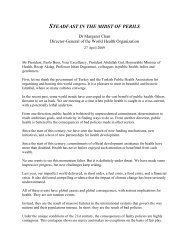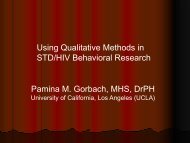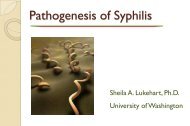The Evolution of HTA in Emerging Markets Health-Care ... - TREE
The Evolution of HTA in Emerging Markets Health-Care ... - TREE
The Evolution of HTA in Emerging Markets Health-Care ... - TREE
You also want an ePaper? Increase the reach of your titles
YUMPU automatically turns print PDFs into web optimized ePapers that Google loves.
OHE Consult<strong>in</strong>g Report for PhRMA<br />
5 January 2011<br />
uses a complicated set <strong>of</strong> rules that has the median reference price as a ceil<strong>in</strong>g, <strong>in</strong>clud<strong>in</strong>g gett<strong>in</strong>g the<br />
lowest price among the reference countries. Interest<strong>in</strong>gly, up to a 10% premium might be given for<br />
“hav<strong>in</strong>g pharmacoeconomics results <strong>in</strong> Taiwan.”<br />
Accord<strong>in</strong>g to Doherty, et al. (2004), as <strong>of</strong> that time, if the estimated market <strong>of</strong> a new product was<br />
expected to exceed NT$100 million per year (New Taiwan dollars), then a price-‐volume negotiation<br />
could be considered. <strong>The</strong> BNHI could negotiate the price <strong>of</strong> new product with the supplier for 3<br />
years, and at the end <strong>of</strong> the third year, a pharmacoeconomic study (on Taiwanese populations)<br />
would have been conducted and the results <strong>of</strong> that study used to negotiate a price. If a new product<br />
were first <strong>in</strong>troduced <strong>in</strong>to the Taiwan market, the BNHI could request <strong>HTA</strong> evidence.<br />
Pharmacoeconomic evidence could be referenced from overseas literature <strong>in</strong> cases where there is<br />
lack <strong>of</strong> local data or (physician) experience. Generally speak<strong>in</strong>g, it appeared that <strong>HTA</strong>, as <strong>of</strong> that<br />
time, had been well embraced by academia, <strong>in</strong>dustry and healthcare decision-‐makers <strong>in</strong> Taiwan<br />
(Doherty et al., 2004). This <strong>in</strong>terest <strong>in</strong> <strong>HTA</strong> looked ever more appropriate when one considers<br />
evidence that drug (reimbursement) price is not the primary driver <strong>of</strong> <strong>in</strong>creased spend<strong>in</strong>g <strong>in</strong> Taiwan.<br />
More recently, however, circumstances have changed. Apparently, the BNHI never actually<br />
announced this threshold to the public, and they did not necessarily follow it. Some products with<br />
budget impact <strong>of</strong> less than NT$100million have been required to sign a price-‐volume agreement to<br />
enable the drug to be reimbursed. However, BNHI has recently mentioned that they will consider<br />
sett<strong>in</strong>g a threshold for encourag<strong>in</strong>g or requir<strong>in</strong>g a price-‐volume agreement, maybe higher than<br />
NY$100million, but this is not yet decided and announced. Also, with regard to the aim to conduct a<br />
pharmacoeconomic study by the end <strong>of</strong> the 3 year agreement, it is an outdated practice that has not<br />
been followed.<br />
A3.8 <strong>Health</strong> Technology Assessment <strong>in</strong> Taiwan<br />
Overview<br />
<strong>The</strong> Division <strong>of</strong> <strong>Health</strong> Technology Assessment (D<strong>HTA</strong>) was established <strong>in</strong> 2007 as a pilot program <strong>in</strong><br />
the CDE, a private, not-‐for-‐pr<strong>of</strong>it, non-‐governmental organization, and fully sponsored by the<br />
Department <strong>of</strong> <strong>Health</strong>. <strong>The</strong> purpose <strong>of</strong> the <strong>HTA</strong> group is to support the BNHI by provid<strong>in</strong>g evidence-based<br />
evaluations <strong>of</strong> the merits or drawbacks <strong>of</strong> new healthcare technologies. Currently, there are<br />
four types <strong>of</strong> new drug applications that are sent to the <strong>HTA</strong> division for review: new chemical<br />
entities, new <strong>in</strong>dications, new dosage forms, and new comb<strong>in</strong>ations. When the <strong>HTA</strong> group receives<br />
these new drugs for review, they assign each case to 2 experts who search <strong>in</strong>dependently for<br />
evidence from CADTH (Canada), NICE (United K<strong>in</strong>gdom), PBAC (Australia), SMC (Scotland), the<br />
Cochrane library, PubMed, EMBASE, etc. A typical report is completed and verified with<strong>in</strong> 42 days<br />
upon which it is dissem<strong>in</strong>ated to the BNHI for the DBC meet<strong>in</strong>g.<br />
101








